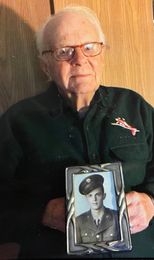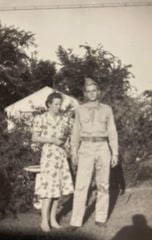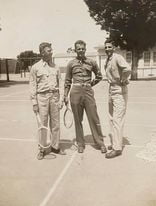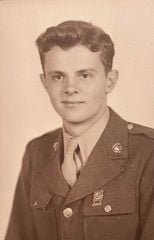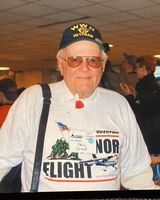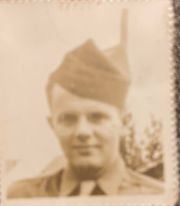107th Mechanized Cavalry Trooper of the Month
Paul Shoaf
 Paul led an interesting life. He was a WWII veteran, owned an auto repair business, for a short time he was a SCUBA diver for the Columbus Police Department, was a pilot, a pilot instructor and much more. Paul had a great sense of humor and if friends were money, Paul was rich. I have attached his bio below.
Paul led an interesting life. He was a WWII veteran, owned an auto repair business, for a short time he was a SCUBA diver for the Columbus Police Department, was a pilot, a pilot instructor and much more. Paul had a great sense of humor and if friends were money, Paul was rich. I have attached his bio below.
T/5 Paul Shoaf
ASN# 35764987
Entered the service 28 June 1943
Awards: Bronze Star, Good Conduct, American Campaign, European Theater of
Operations (3 stars: Central Europe, Northern France & Rhineland) & WWII Victory medal.
Paul was born 26 September 1924 in Columbus, Ohio. He was in the 107th Light Mechanized Cavalry. He served in Europe as a driver/mechanic in a Stewart tank.
The 1st Ohio Cavalry consolidated on 1 November 1940 with the 22nd Reconnaissance Squadron (organized and federally recognized 15 September 1939 with headquarters at Cincinnati) and the consolidated unit was designated as the 107th Cavalry Regiment (United States); it was concurrently relieved from assignment to the 22nd Cavalry Division and was inducted into federal service on 5 March 1941 at its home stations in Ohio.
The regiment was broken up on 1 January 1944 and its elements reorganized and redesignated as follows:
- Headquarters and Headquarters Troop as Headquarters and Headquarters Troop, 107th Cavalry Group, Mechanized.
- 2nd Squadron as the 107th Cavalry Reconnaissance Squadron, Mechanized.
- 1st Squadron as the 22nd Cavalry Reconnaissance Squadron, Mechanized (hereafter separate lineage).
Paul was born 26 September 1924 in Columbus, Ohio. He grew up in a neighborhood know as Little Oklahoma. He was very good friends with Luther Crabtree. He had some teenage issues and was given a choice between youth detention and the military. Wisely he chose to the military. He was processed at Fort Hayes in Columbus, Ohio. He took boot camp at Fort Riley, Kansas.
Fort Riley in World War II
Gathering war clouds in Europe and Asia during the late 1930s caused some military planners to prepare for possible U. S. involvement. This led to several important developments at Fort Riley. The first was the rebuilding of Camp Funston and the stationing of the 2nd Cavalry Division there in December 1940. Barracks were built in the area known as Republican Flats and renamed Camp Forsyth. In addition, 32,000 acres (129 km²) were added to the post for training purposes. These efforts were brought into sharp focus with America’s entry into World War II. Over the next four years, approximately 125,000 soldiers were trained at these facilities. Notable trainees included heavyweight boxing champion, Joe Louis, Indy car driver Walt Faulkner and motion picture stars such as Mickey Rooney. The post also received a presidential visit by Franklin Roosevelt on Easter Sunday 1943. The 9th Armored Division was organized here in July 1942 and after its deployment, Camp Funston was used as a German prisoner of war camp. Fort Riley had branch POW camps, a large branch Camp Phillips in Salina, and 12 smaller branch camps in Kansas and Missouri: Council Grove, El Dorado, Eskridge, Hutchinson, Lawrence, Neodesha, Ottawa, Peabody, Wadsworth, Grand Pass, Lexington, Liberty.
He left Ft. Riley and was sent to motor mechanic school. He proceeded to Sebastopol, California assigned to the 107th Mechanized Cavalry, Company “F”. He trained in the motor pool and then returned to Ft. Riley. He trained there as a mechanic on the Cadillac engines, engine maintenance & hydraulic transmissions repairs. He returned to California and was now promoted to T/5 (tech corporal). He was a driver for the maintenance tank & wheeled vehicles.
Company F was comprised of 88 men, three mechanics, 18 tanks, two Jeeps, one half track and one 6×6 truck. He enjoyed working on and driving all the different vehicles. Since he had this duty he did not have to do KP or Guard Duty. They moved from Sebastopol, California to Belmont, California. From there they went to Camp Hood Texas.
WWII Fort Hood is a U.S. military post located in Killeen, Texas. The post is named after Confederate General John Bell Hood. It is located halfway between Austin and Waco, about 60 miles (100 km) from each, within the U.S. state of Texas. Fort Hood is an installation of the United States Army and is the largest military base in the world (by area) with more than 215,000 acres. Its origin was the need for wide-open space to test and train with World War II tank destroyers. The War Department announced the location in January 1942, and the initial completion was set for that August. As originally constructed, Fort Hood had an area of 158,706 acres (64,226 ha), with billeting for 6,007 officers and 82,610 enlisted personnel. They were sent to Camp Shanks in New York. 107th sailed from the Port of New York on 3 January 1945 and landed at Le Havre, France on 16 January 1945.
Camp Shanks was a United States Army installation in the town of Orangetown in Rockland County, New York. Named after Major General David Carey Shanks (1861–1940), it was situated near the juncture of the Erie Railroad and the Hudson River. The camp was the largest U.S. Army embarkation camp used during World War II. Camp Shanks served as a point of embarkation for troops departing overseas during World War II. Dubbed “Last Stop USA”, the camp housed about 50,000 troops spread over 2,040 acres (8.3 km2) and was the largest World War II Army embarkation camp, processing 1.3 million service personnel including 75% of those participating in the D-Day invasion. In 1945 Camp Shanks housed German and Italian prisoners of war.
When they arrived in Le Havre, France and then were moved to Camp Lucky Strike near Cany Barville, France for three weeks of training unpacking equipment that had been shipped from Fort Hood. It was cold and wet. They spent their first night in a 60 man unheated tent, located in a potato field. As mechanics we were taken from “Camp Lucky Strike” to Le Havre to process our vehicles as they were unloaded from the ship. We returned them to our Company. We departed “Camp Lucky Strike” to a location outside of St. Nazaire that was being held by the Germans.
Camp Lucky Strike was situated in the town of Saint-Sylvian, 5 kilometers from Saint-Valery-en Caux. Its location was not selected by chance, but rather because the occupying German troops had constructed an airfield there in 1940 with a landing strip 1800 meters long and 50 meters wide. This airfield was one of the defensive elements of the Atlantic Wall: surveillance and coastal defenses were also a perfect starting point for attacks on southwest England. V-1 rocket launching ramps were installed at the beginning of 1944 in the woods surrounding the airfield. It was heavily bombed by the British throughout the war, but especially during the fighting which followed the June 1944 landings. In September 1944 American Engineer Corps troops took control of the area, repairing the landing strips and constructing the camp.
The camp became the most important military camp in Europe. It extended over 600 hectares (1 hectare = approximately 2 ½ acres). It was a mandatory port of entry for practically every American soldier, and 1½ million spent from a couple days up to 18 months there. It was the principal camp used for repatriated soldiers and liberated POWs, but also as a reception station for soldiers on leave. It was also a staging area for the Pacific Theater and — until August 10, 1945 — for the invasion of Japan. There were 100,000 men in the camp each day — 100,000 men to lodge, feed, train, and entertain. (Regarding repatriation, there were 6,000 daily departures by plane or boat from Le Havre, the only port liberated on the western coast that could accommodate large ships.)
The camp, where the 89th Infantry Division managed the reception of troops, was a veritable American city for 18 months. Life was therefore rhythmical with this enormous hub of military personnel, short stopover for some, several months for others. One could find, like in any American city, a hospital, church, movie theater, post office, police station, barber shop, and a supermarket. There were also concerts and shows with famous celebrities (Bob Hope and Mickey Rooney, among others). And around the camp, there were the usual prostitutes and easy access to the local black market.
In March and April the Squadron was assigned to the 15th Army and attached to the 66th Infantry Division in Brittany, with the mission of containing the enemy forces in the ST. Nazaire Pocket. Late in April the Squadron was assigned to the 7th Army and attached to the 103rd Infantry Division with reconnaissance and security missions preformed from Langenan, Germany to Schrnitz, Austria. The Squadron sailed from Marseilles, France with orders for redeployment to Manila and the Pacific Theatre. With the surrender of the Japanese and the end of World War II, the Squadron was directed to Hampton Roads, Virginia where the landed on 21 August.
Paul remembered that is was so muddy they had to move to the Autobahn to move through to Munich, Germany. While in moving through the rail yards Munich his friend Marvin Russo (gunner) was standing on the tank that Paul was driving. He was hit by a low hanging power line. He saw the medics administering a heart stimulant. Paul didn’t know until three years later that Marvin survived. This really affected Paul. Marvin lost the use of his left arm.
Paul said while in southern Germany near the Alps in Bavaria they came across a concentration camp that had been liberated by the Americans three or four days before. He said this was hard to forget.
In an attack during the war he was subject to a mortar blast. This is something he struggled with after the war. He had a buzzing in his ears. Most of the time in France and Germany his time was spent outside, sleeping in tents in a sleeping bag or sleeping on the radiators of the tank top keep warm and dry. Paul said most of the time they assisted the evacuation of wounded by carrying them on the tank away from the battlefield.
Paul recounted the tanks he was in during his time in Europe. The first became lodge in a bomb crater and they disabled it with grenades. The second tank was hit by a round in the rear idler wheel and was later picked up by a Tank Retriever. The third vehicle he was assigned to towards the end of the war, in Germany, was a Tank Retriever. The Retriever had a 500 HP V8 engine with a wench.
When he arrived back in the states he went to Roswell, New Mexico. He was there for a month guarding German POW’s. From there he was sent to Camp Atterbury to be processed for discharge.
Paul also went through the Alps to the Eagles Nest Berchtesgaden. He said when they approached the Eagles Nest, the medium tanks moved the road blocks and his tanks carried wounded.

